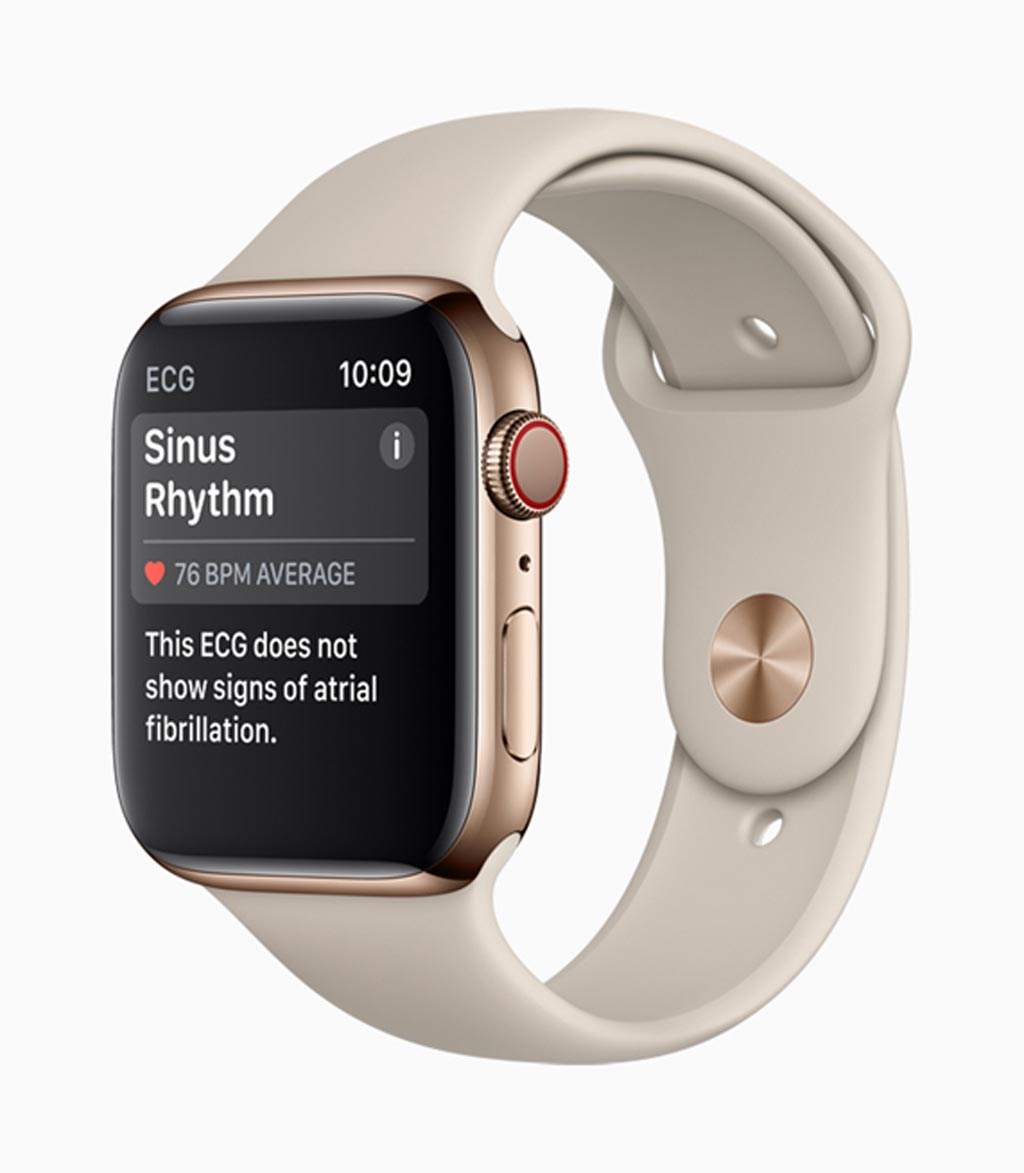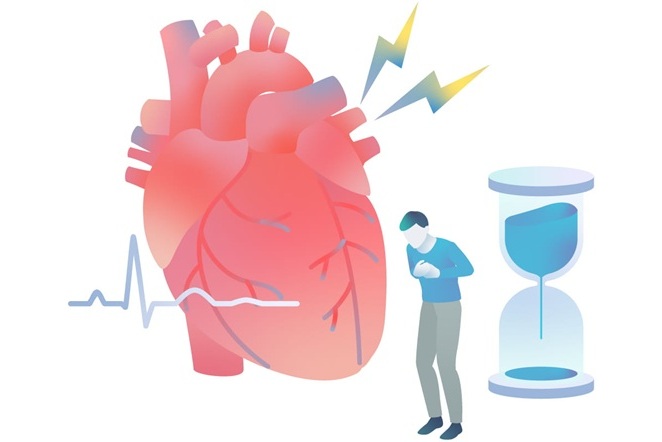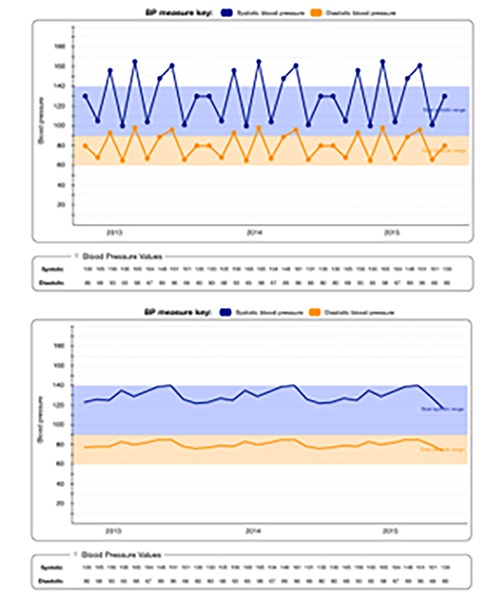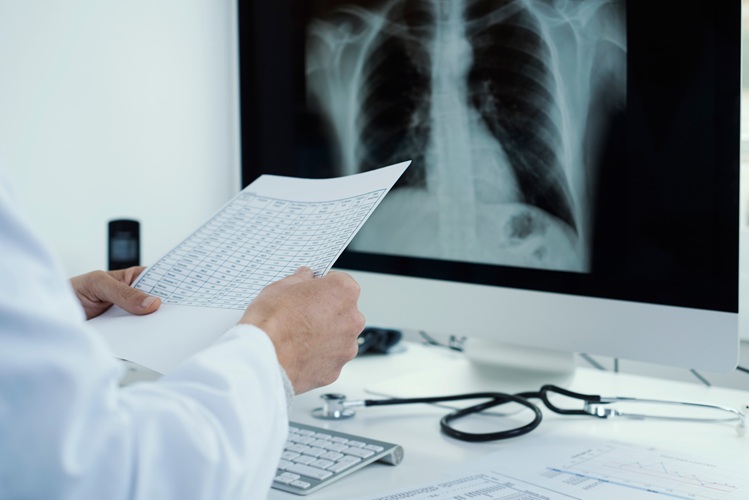New Apple Watch Includes Built-in ECG
|
By HospiMedica International staff writers Posted on 27 Sep 2018 |

Image: The new Apple Watch can take an ECG (Photo courtesy of Apple).
The latest iteration of the Apple (Cupertino, CA, USA) Watch, the Series 4, includes an electrocardiogram (ECG) sensor, officially classifying it as a medical device capable of alerting its user to abnormal heart rhythms. The new smartwatch was revealed at the recent September 2018. Apple iPhone launch event.
To obtain an ECG, users touch and hold the side of the watch while it sends an electric current through the chest to the opposite hand; after 30 seconds, the device measures heart rhythms using electrodes built into the back of the sapphire crystal and the digital crown. The sensor classifies them, alerting the user if there are signs of atrial fibrillation (AF). The watch also intermittently analyzes heartbeats in the background for irregularities, or if pulse exceeds or falls below a specified threshold. All data recordings and any noted symptoms are stored in the watch’s Health app in a PDF file format that can be shared with physicians.
Additional health features include fall detection, which works by analyzing wrist trajectory and impact acceleration. If needed, the Watch will initiate an emergency call. If it senses the user is immobile for one minute, it will automatically call and send a message to emergency contacts using the native SOS feature. Other improvements include enhanced fitness and health tracking, walkie-talkie mode, a breath feature to guide breathing for meditation, and more. An app unlocking the wrist-based ECG functionality will be available to consumers in the United States in late 2018.
“We’re thrilled Apple Watch has become an essential part of people's lives,” said Jeff Williams, chief operating officer at Apple. “The completely redesigned Apple Watch Series 4 continues to be an indispensable communication and fitness companion, and now with the addition of groundbreaking features, like fall detection and the first-ever ECG app offered directly to consumers, it also becomes an intelligent guardian for your health.”
“We’re enthused by what we see currently happening in digital health. Recent product approvals and clearances have given consumers and providers access to powerful technologies that have the potential to advance the delivery of health care,” commented FDA Commissioner Scott Gottlieb, MD. “We know that our actions will help encourage the development of incredibly innovative products. We hope to see health care adopting more and more disruptive technologies that positively impact people’s lives.”
While retaining its original design, the fourth-generation Apple Watch includes a 30% larger display, which is seamlessly integrated into a thinner, smaller case, with a new user interface that provides more information with richer detail. The Series 4 runs on watchOS 5, which provides advanced activity and communications features, a new accelerometer and gyroscope which measures up to 32 g forces, and an electrical heart rate sensor that has been granted a De Novo classification by the U.S. Food and Drug Administration (FDA) as a Class II medical device.
Related Links:
Apple
To obtain an ECG, users touch and hold the side of the watch while it sends an electric current through the chest to the opposite hand; after 30 seconds, the device measures heart rhythms using electrodes built into the back of the sapphire crystal and the digital crown. The sensor classifies them, alerting the user if there are signs of atrial fibrillation (AF). The watch also intermittently analyzes heartbeats in the background for irregularities, or if pulse exceeds or falls below a specified threshold. All data recordings and any noted symptoms are stored in the watch’s Health app in a PDF file format that can be shared with physicians.
Additional health features include fall detection, which works by analyzing wrist trajectory and impact acceleration. If needed, the Watch will initiate an emergency call. If it senses the user is immobile for one minute, it will automatically call and send a message to emergency contacts using the native SOS feature. Other improvements include enhanced fitness and health tracking, walkie-talkie mode, a breath feature to guide breathing for meditation, and more. An app unlocking the wrist-based ECG functionality will be available to consumers in the United States in late 2018.
“We’re thrilled Apple Watch has become an essential part of people's lives,” said Jeff Williams, chief operating officer at Apple. “The completely redesigned Apple Watch Series 4 continues to be an indispensable communication and fitness companion, and now with the addition of groundbreaking features, like fall detection and the first-ever ECG app offered directly to consumers, it also becomes an intelligent guardian for your health.”
“We’re enthused by what we see currently happening in digital health. Recent product approvals and clearances have given consumers and providers access to powerful technologies that have the potential to advance the delivery of health care,” commented FDA Commissioner Scott Gottlieb, MD. “We know that our actions will help encourage the development of incredibly innovative products. We hope to see health care adopting more and more disruptive technologies that positively impact people’s lives.”
While retaining its original design, the fourth-generation Apple Watch includes a 30% larger display, which is seamlessly integrated into a thinner, smaller case, with a new user interface that provides more information with richer detail. The Series 4 runs on watchOS 5, which provides advanced activity and communications features, a new accelerometer and gyroscope which measures up to 32 g forces, and an electrical heart rate sensor that has been granted a De Novo classification by the U.S. Food and Drug Administration (FDA) as a Class II medical device.
Related Links:
Apple
Latest Patient Care News
- Portable Biosensor Platform to Reduce Hospital-Acquired Infections
- First-Of-Its-Kind Portable Germicidal Light Technology Disinfects High-Touch Clinical Surfaces in Seconds
- Surgical Capacity Optimization Solution Helps Hospitals Boost OR Utilization

- Game-Changing Innovation in Surgical Instrument Sterilization Significantly Improves OR Throughput
- Next Gen ICU Bed to Help Address Complex Critical Care Needs
- Groundbreaking AI-Powered UV-C Disinfection Technology Redefines Infection Control Landscape
- Clean Hospitals Can Reduce Antibiotic Resistance, Save Lives
- Smart Hospital Beds Improve Accuracy of Medical Diagnosis
- New Fast Endoscope Drying System Improves Productivity and Traceability
- World’s First Automated Endoscope Cleaner Fights Antimicrobial Resistance
- Portable High-Capacity Digital Stretcher Scales Provide Precision Weighing for Patients in ER
- Portable Clinical Scale with Remote Indicator Allows for Flexible Patient Weighing Use
- Innovative and Highly Customizable Medical Carts Offer Unlimited Configuration Possibilities
- Biomolecular Wound Healing Film Adheres to Sensitive Tissue and Releases Active Ingredients
- Wearable Health Tech Could Measure Gases Released From Skin to Monitor Metabolic Diseases
- Wearable Cardioverter Defibrillator System Protects Patients at Risk of Sudden Cardiac Arrest
Channels
Critical Care
view channel
Breakthrough AI Technology Accurately Assesses Heart Failure Severity
Heart failure (HF) is a complex condition where the heart cannot effectively pump blood to meet the body’s needs due to underlying medical issues. It is marked by recurring episodes and frequent hospitalizations.... Read more
New Approach to Visualizing Blood Pressure Data Can Help Better Manage Hypertension Patients
Sometimes, a patient’s blood pressure may be elevated in a doctor's office but normal at home, a phenomenon known as white coat hypertension. It is estimated that 10% to 20% of high blood pressure diagnoses... Read moreSurgical Techniques
view channel
DNA Origami Improves Imaging of Dense Pancreatic Tissue for Cancer Detection and Treatment
One of the challenges of fighting pancreatic cancer is finding ways to penetrate the organ’s dense tissue to define the margins between malignant and normal tissue. Now, a new study uses DNA origami structures... Read more
Pioneering Sutureless Coronary Bypass Technology to Eliminate Open-Chest Procedures
In patients with coronary artery disease, certain blood vessels may be narrowed or blocked, requiring a stent or a bypass (also known as diversion) to restore blood flow to the heart. Bypass surgeries... Read more
Intravascular Imaging for Guiding Stent Implantation Ensures Safer Stenting Procedures
Patients diagnosed with coronary artery disease, which is caused by plaque accumulation within the arteries leading to chest pain, shortness of breath, and potential heart attacks, frequently undergo percutaneous... Read more
World's First AI Surgical Guidance Platform Allows Surgeons to Measure Success in Real-Time
Surgeons have always faced challenges in measuring their progress toward surgical goals during procedures. Traditionally, obtaining measurements required stepping out of the sterile environment to perform... Read moreHealth IT
view channel
Printable Molecule-Selective Nanoparticles Enable Mass Production of Wearable Biosensors
The future of medicine is likely to focus on the personalization of healthcare—understanding exactly what an individual requires and delivering the appropriate combination of nutrients, metabolites, and... Read more
Smartwatches Could Detect Congestive Heart Failure
Diagnosing congestive heart failure (CHF) typically requires expensive and time-consuming imaging techniques like echocardiography, also known as cardiac ultrasound. Previously, detecting CHF by analyzing... Read moreBusiness
view channel
Expanded Collaboration to Transform OR Technology Through AI and Automation
The expansion of an existing collaboration between three leading companies aims to develop artificial intelligence (AI)-driven solutions for smart operating rooms with sophisticated monitoring and automation.... Read more

















